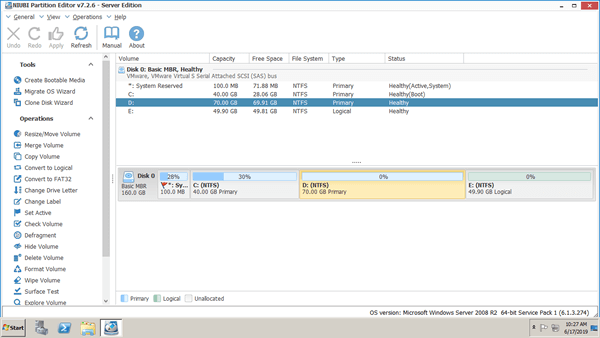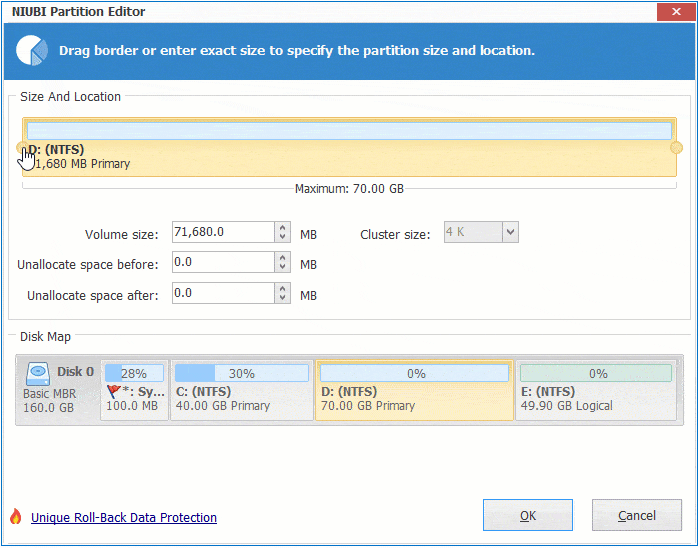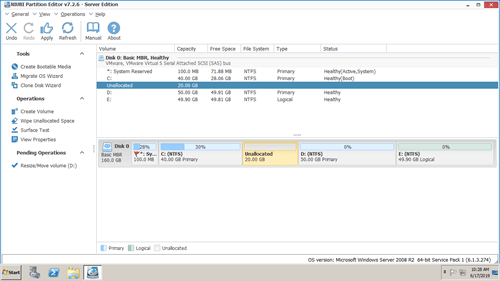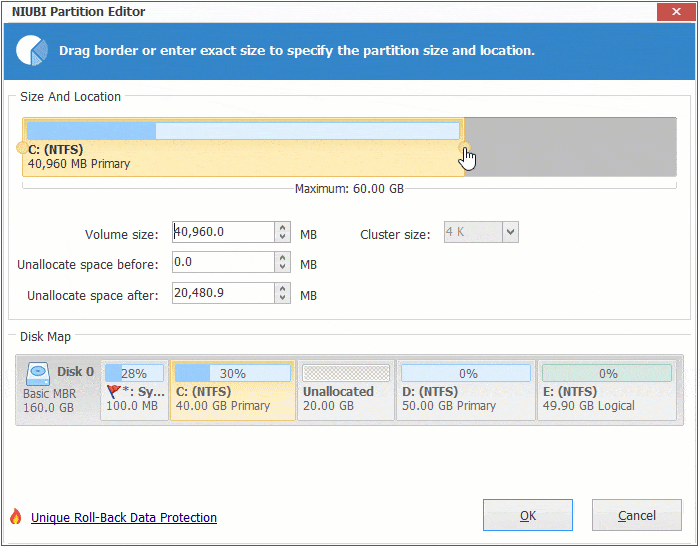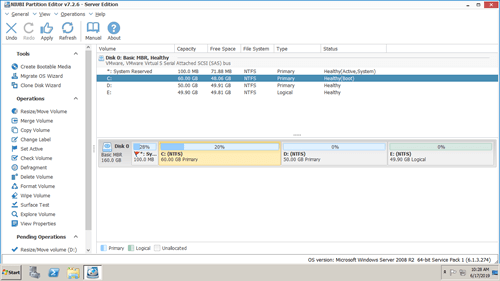When system C drive is getting full in Windows 2008 server, if you contact support from OEM manufacturer, they'll tell you to back up everything, delete and recreate partitions, finally restore from backup. If you do like that, the whole weekend will be wasted. It can't be better if you extend Server 2008 partition with free space in another volume. Better than previous version, Windows Server 2008 has Diskpart command and Disk Management to help extend partition without losing data (in most cases). However, they only work under restricted condition. In most cases, you still need disk partition software. This article introduces how to extend volume in Windows Server 2008 R2 with 3 kinds of tools.
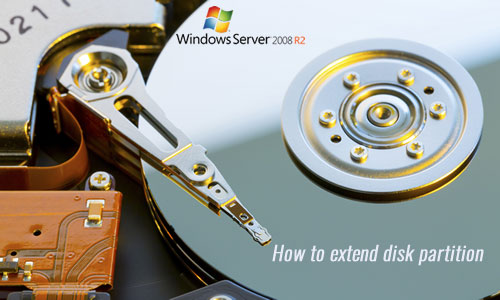
1. Extend volume in Windows Server 2008 with Disk Management
To extend Server 2008 partition with Disk Management, your disk partition structure must meet all requirements below:
- The partition that you want to extend (such as C:) must be formatted with NTFS file system.
- There is another partition (such as D:) adjacent and on the right of the drive that you want to extend.
- You must delete the right contiguous partition (D) to get unallocated space before extending partition (C).
- On MBR disk, the partitions that you want to delete and extend must be the same primary or logical partition.
If your disk partition configuration meet the requirements, you can extend Server 2008 volume without any software.
How to extend volume in Server 2008 R2 with Disk Management:
- Press Windows and R together on keyboard, type diskmgmt.msc and press "Enter".
- Right click the right adjacent partition (such as D:) and select "Delete Volume", then the disk space will be changed to unallocated.
- Right click the partition that you want to extend (such as C:) and select "Extend Volume".
- Simply follow up the pop-up "Extend Volume Wizard".
Together with Extend Volume, there is another Shrink Volume function in Disk Management, why not extend C drive by shrinking D or other partition?
Because to extend partition in Server 2008 Disk Management, there must be adjacent unallocated space on the right. The "Shrink Volume" function cannot make such required unallocated space. As you see in the screenshot, unallocated space can only be made on the right when shrinking D drive. This space is nonadjacent to C drive, therefore, Extend Volume is grayed out.
2. How to extend Server 2008 partition with diskpart cmd
The same with previous Server 2003, you can extend partition in Windows Server 2008 (R2) with Diskpart command. But the same with Disk Management, diskpart can only extend NTFS partition by deleting the right contiguous volume. Diskpart works in different way, but it has same restrictions with Disk Management tool.
Unlike Disk Management that displays partition layout and detailed information, diskpart only displays single partitions in a list. In addition, it doesn't display any unallocated space.
Steps to extend partition in Server 2008 R2 with Diskpart command:
- Press Windows and R together, type diskpart and press "Enter".
- Input list volume and press Enter in the command prompt window, then you'll see all partitions.
- Input select volume D and press Enter. (D is the right adjacent drive.)
- Input delete volume and press Enter.
- Input select volume C and press Enter. (C is the partition that you want to extend.)
- Input extend and press Enter.
Note: if you want to extend this partition with only part of unallocated space, input extend desired=XX (XX is amount in MB).

3. Extend volume in Server 2008 R2 with NIUBI Partition Editor
To extend volume in Windows 2008 server, third party software is better choice. Because comparing with Windows native tools, disk partition software has many advantages such as:
- They can shrink and extend both NTFS and FAT32 partitions.
- They can make unallocated space on either left or right side while shrinking a partition.
- They can add unallocated space to either contiguous and any nonadjacent partitions on the same disk.
- Move, merge, convert, wipe, copy disk partition, scan bad sectors, optimize file system and much more.
There's potential data loss risk while resizing disk partitions, because all parameters of associated disk, partition and files must be modified correctly. Some unreliable software could cause system boot failure, partition damage and data loss. Therefore, before extending volume in Windows 2008 server, make a backup and run safe program.
Better than other tools, NIUBI Partition Editor has powerful technologies to protect system and data:
- Virtual Mode - all operations will be listed as pending for preview, real disk partitions won't be modified until click "Apply" to confirm.
- Cancel-at-will - if you applied wrong operations, you can cancel the ongoing operations without damaging partitions.
- 1 Second Rollback - if any error is detected while resizing partition, it automatically reverts server to original status in a flash.
- Hot Clone - clone disk partition without server interruption, you can clone system disk regularly as backup and boot from the clone disk immediately whenever system disk goes wrong.
How to extend partition in Windows Server 2008 R2 without losing data:
① Download NIUBI Partition Editor and you'll see the main window with disk partition structure and other information.
② Right click D: (the right adjacent volume) and select "Resize/Move Volume", drag left border towards right in the pop-up window. You may also enter an amount in the box behind "Unallocated space before" (1024MB = 1GB).
③ Right click C: drive and select "Resize/Move Volume", drag right border towards right to combine this unallocated space.
To modify real disk partition, remember to click "Apply" on top left to execute. Otherwise, these operations only work in virtual mode. Watch the video how to operate.
- If you use any types of hardware RAID, do not break RAID array or do any operation to RAID controller, just follow the step above.
- If you want to extend Server 2008 partition in VMware/Hyper-V, just install NIUBI to the virtual server and follow the steps above.
- If there's not enough free space on the same disk, copy this disk to a larger one and extend Server 2008 partition(s) with additional disk space. (To virtual servers, you can expand disk with VMware/Hyper-V own tools. After that, additional space will be shown as unallocated at the end of disk, follow the steps to merge unallocated space to C drive or other partition.)
Besides shrinking and extending partition in Windows Server 2008/2012/2016/2019/2022, NIUBI Partition Editor helps you do many other disk and partition management operations.


